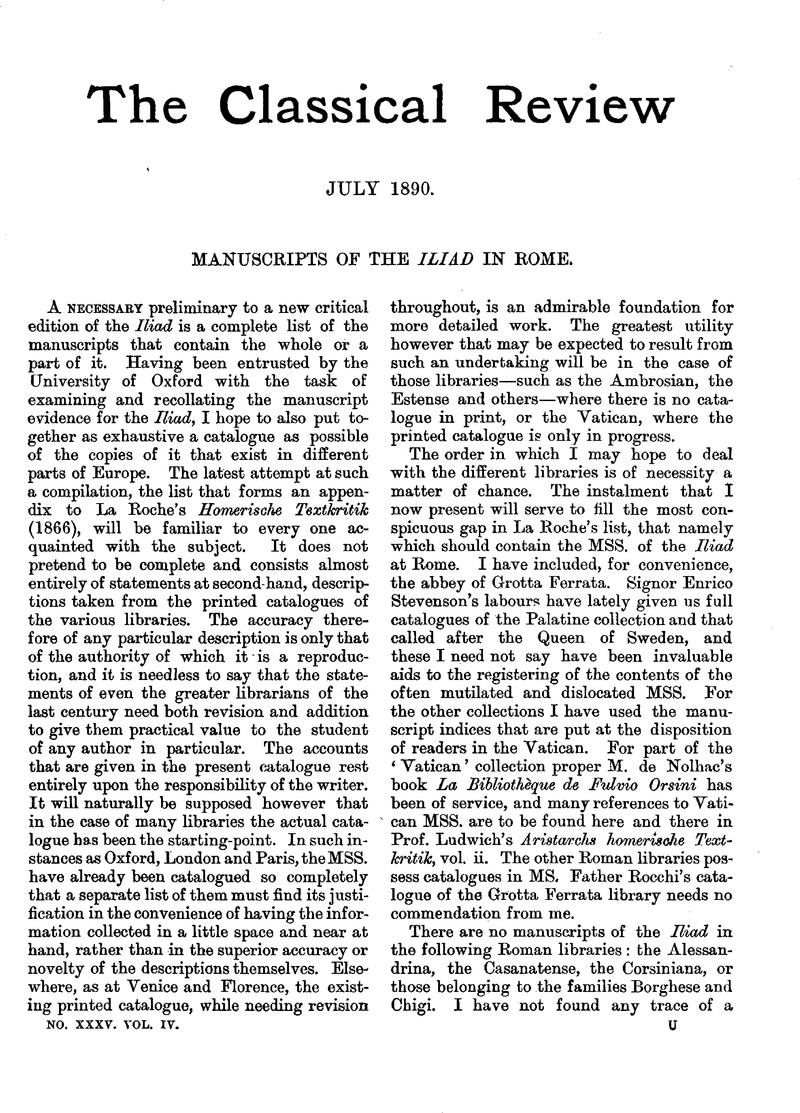No CrossRef data available.
Article contents
Manuscripts of the Iliad in Rome
Published online by Cambridge University Press: 27 October 2009
Abstract

- Type
- Review Article
- Information
- Copyright
- Copyright © The Classical Association 1890
References
page 290 note 1 In the same year a copy of the Iliad, Odyssey, and Batrachomyomachia, now Laur. 32, 6, was written at Bologna by Rhosus. I have not been able to identify 
page 290 note 2 Christophorus Garathon was the owner of the ms. Laur. 70, 34 written in Constantinople in 1427.
page 290 note 3 MSS. Vat. 32 and 33 contain scholia minora to the Iliad; the latter is alluded to by Ludwich, Aristarchs hom. Textkritik ii. 512 note, and Maass, Scholia Townleyana vol. 2 p. It may be well to give some additional particulars of the former, which seems to have escaped notice. Vat. 32, membr. 11½ × 9½, ff. 139, signed quaternions, has the last leaf (f. 139) restored by a later hand upon a piece of palimpsest; after six lines necessary to complete the text come the following in the same hand: 


page 291 note 1 Upon the paraphrase cf. Ludwich l.c., p. 548.
page 291 note 2 Cf. de Nolhac, , La Bibliothèque de Fulvio Orsini, p. 336Google Scholar.
page 291 note 3 De Nolhac, l.c., p. 167n. 3. I confess to having taken from M. de Nolhac the statement that books Λ—N are missing. The fact had escaped me.
page 291 note 4 De Nolhac, l.c., p. 165 n. 2.
page 291 note 5 ib. n. 3.
page 291 note 6 Cf. de Nolhac, l.c., ib. n. 4.
page 291 note 7 de Nolhac, l.c., p. 339, n. 49.
page 291 note 8 Codices Manuscripti Palatini Gracci recensuit et digessit Henricus Stevenson Senior. Romae 1885.
page 291 note 9 This fact has escaped Sig. Stevenson.
page 292 note 1 Codices Manuscripti Graeci Reginae suecorum et Pii PP. II., recensuit et digessit Henricus Stevenson Senior, Romae 1888.
page 292 note 2 There is a full description of this ms, in Heyne, vol. iii. p. xlviii.: he says ‘notitiam eius debeo humanitati Viri Cl. Louis Lamberti.’
page 293 note 1 Codices Cryptenses digesti et illustrati curo, et studio D. Ant. Rocchi Tusculani, 1883.
page 293 note 2 In the number of this Review for October 1889 I gave some particulars of the MS. 6 in this library, which contains scholia minora to the Iliad. I was then unaware that the manuscript had been studied in detail by Prof. Sittl, Sitzungsberichte der philosoph.-philolog. u. historisch. Classe der K. b. Akad. d. Wiss. zu München, 1888 Bd. II. Heftii. pp. 255 sqq. Herr Sittl has shown without a doubt the importance of the MS. and its position in the tradition of the text of Homer, as Prof. Ludwich has recognised (Berliner philologische Wochenschrift, February 16, 1889); but he appears to me to be in error in two points. Firstly, in so decidedly assigning the MS. to the ninth century: it is however at latest of the early part of the tenth; further, p. 257, 8 Sittl explains a double quire-signature that runs through the MS. (e.g. 





